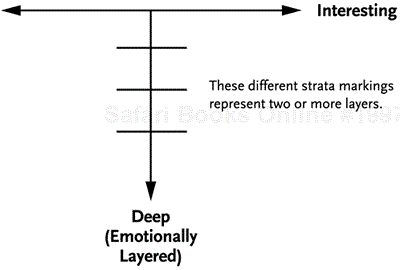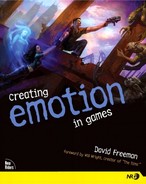Approaching emotion logically.
Approaching playing seriously.
Make things
interesting and make them deep.
Over the course of a decade, as I created and distilled screenwriting and story techniques for “Beyond Structure” and elsewhere, I found that they all fall on one of the two axes of this grid:

The arrow across the top represents techniques to make things interesting—unique, imaginative, original, etc.
The vertical arrow represents techniques to make things “deep”—to give them the feeling of emotional depth or to make them emotionally layered, poignant, soulful, emotionally complex, psychologically complex, etc.
These two categories—making things interesting and making them deep—apply to five areas of writing:
Dialogue
Characters
Relationships between characters
Scenes
Plots
Any of these five can be interesting, deep, or both. Techniques that cause any of the five to be deep are what I call Deepening Techniques.
Emotional pain is just one of many ways to give depth to a line of NPC dialogue. Depth, however, isn't necessarily interesting.
Let's say you're playing a WWII game. You're an American soldier in France, entering a destroyed town from which the Germans just fled. You walk up to a distraught young woman and have this interchange:
YOU: Where did the Germans keep their munitions? The woman doesn't even look at you. She's in shock as she points to some burnt-out rubble. WOMAN: That used to be a church. I had a two-year old son, Michael, who was baptized there. The Germans killed him, and now I feel very sad. She breaks down and sobs.
Deep? Yes, for emotional pain gives a character depth. But is this woman interesting? No. Her dialogue is flat and over-obvious, or, as screenwriters say, it is “on the nose.”
Take another look at the interchange; this time it has been made deep and interesting:
YOU: Where did the Germans keep their munitions? The woman doesn't even look at you. She's in shock as she points to some burnt-out rubble. WOMAN: My son Michael -- he was baptized in that church. She breaks down and sobs.[1]
The fact that “depth” isn't in and of itself necessarily “interesting” applies to all the categories of “deepening” that have been discussed, not just dialogue.
By the way, you probably noticed that, in both examples, the woman didn't answer the question. That was intentional. To get the answer to your question, you may need to ask her again. Or you may have to ask another character, one who isn't as emotionally devastated.
There are at least 1,500 distinct techniques a writer can use to make these five areas of storytelling either (1) interesting or (2) deep, thus creating ten categories in all. All techniques for creating emotion in films and TV fall into one of the ten categories.
For instance, why even have a climax in your story? It's because it makes plots more interesting.
Why is it usually important to care about the lead character, and sometimes other characters as well? Same reason: It makes the plot more interesting if we do.
When it comes to games, as you'll see, there are not ten but rather 32 categories of techniques that you can use to emotionally engage a player.
The line had to be drawn somewhat arbitrarily. For instance, one could keep extending the list of categories to include such elements as lighting, sound design, animation, music, level design, and so on. After all, these can be used to enhance the breadth and depth of emotion in a game as well. However, these get into specialized areas or involve gameplay issues that exceed the scope of this book.
So, please understand that a line had to be drawn. Now, let's get into the techniques.
[1] Many specific techniques for making NPCs both "deep" and "interesting" will be discussed later in this book.
